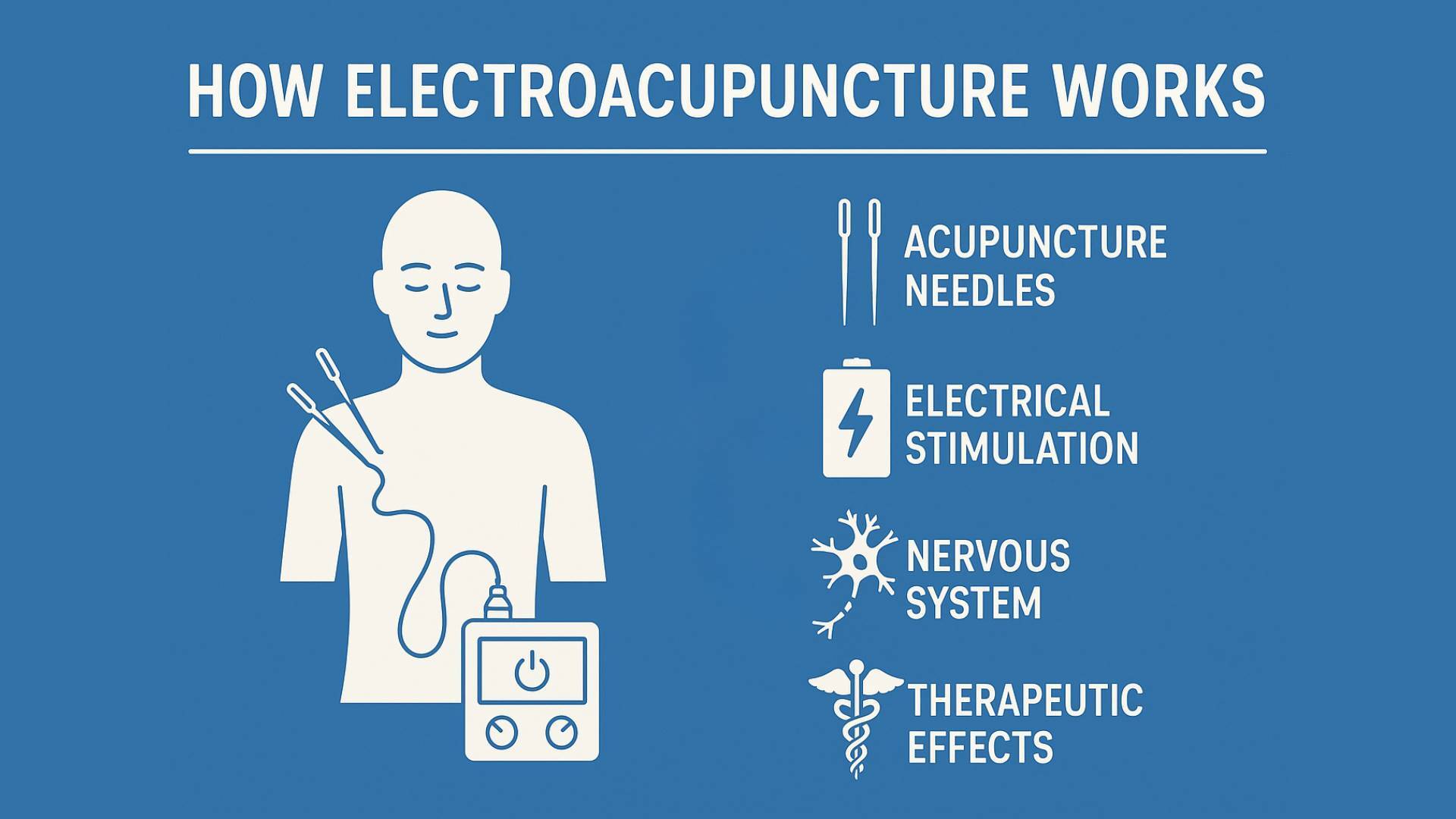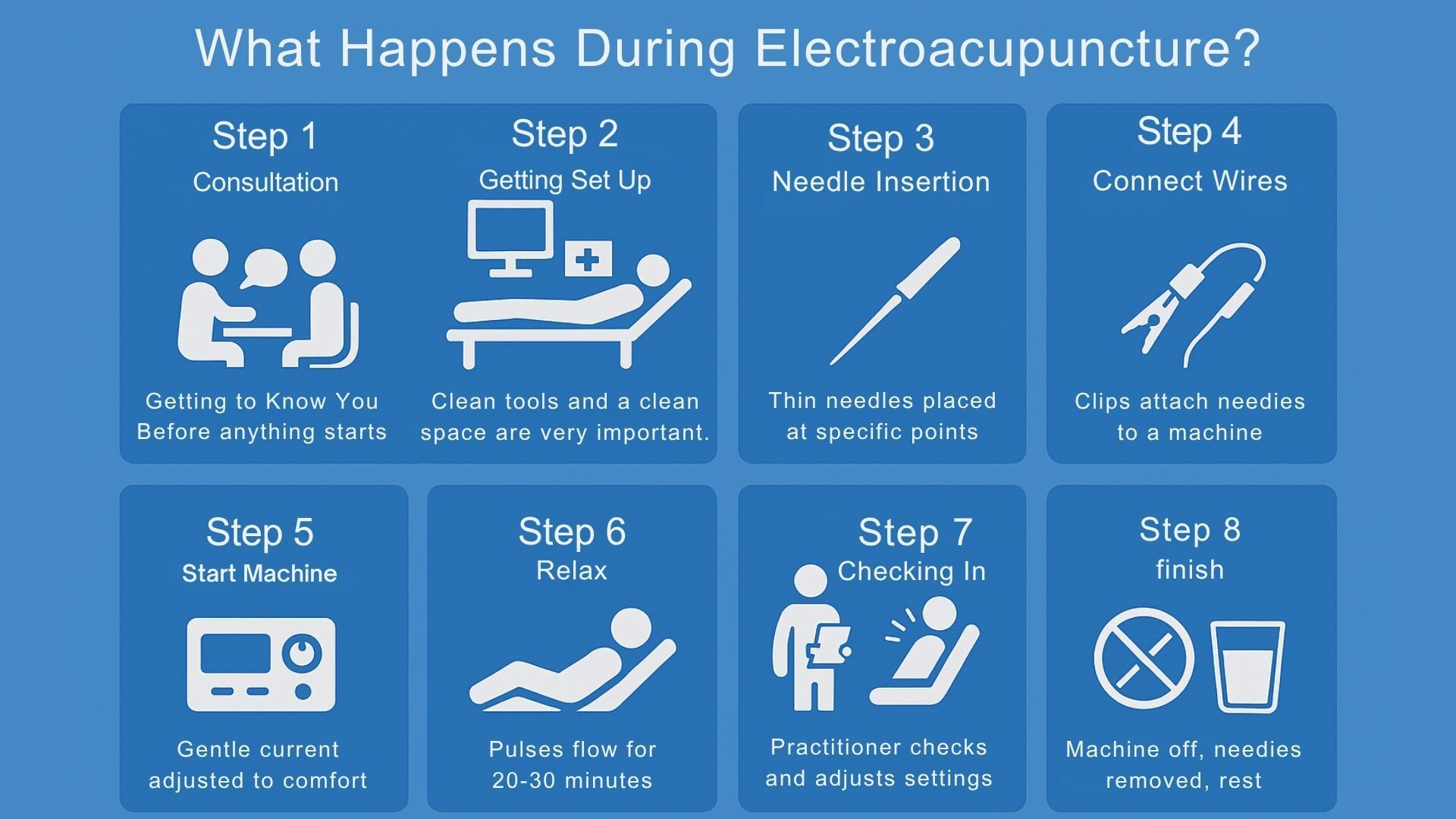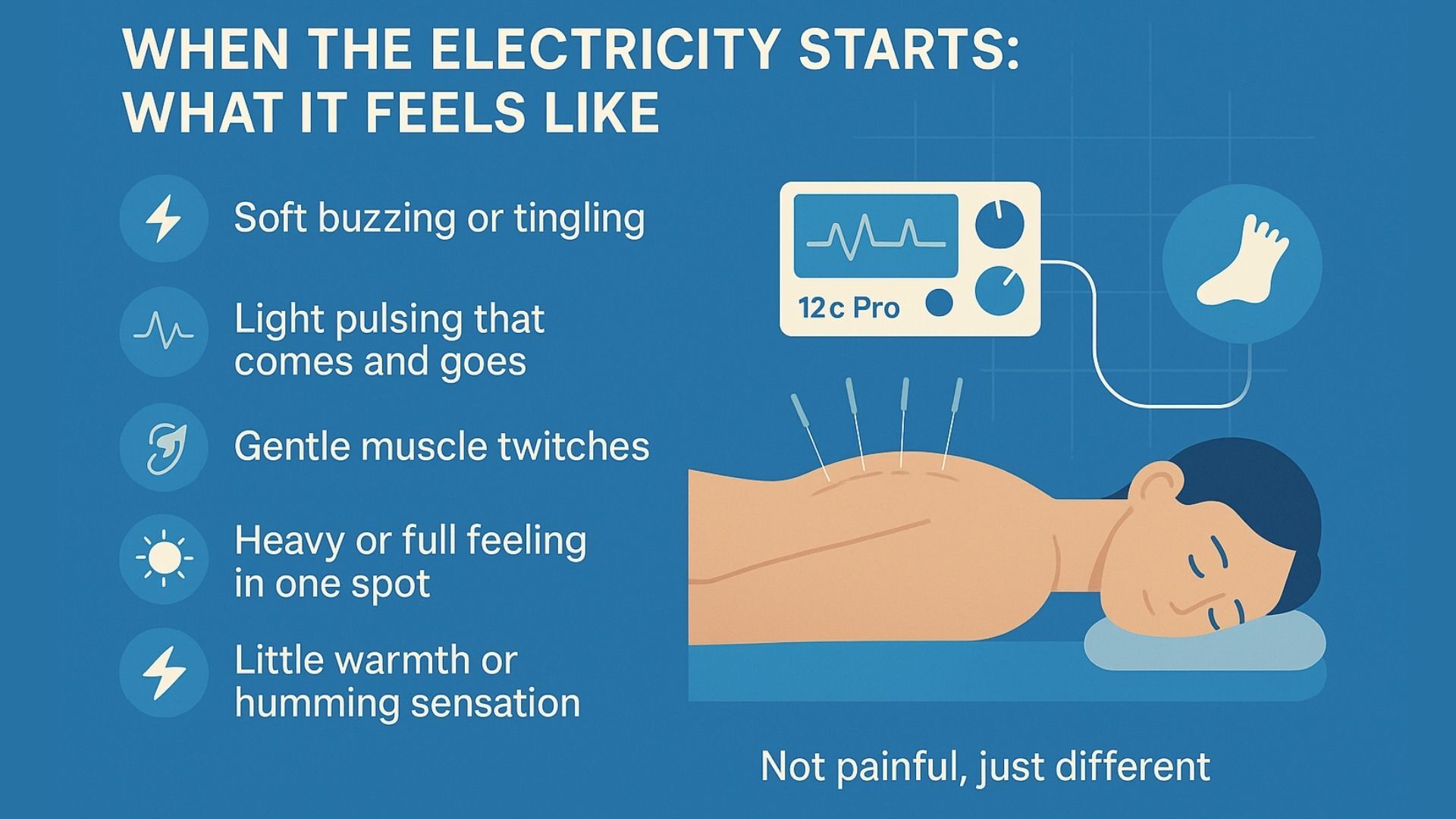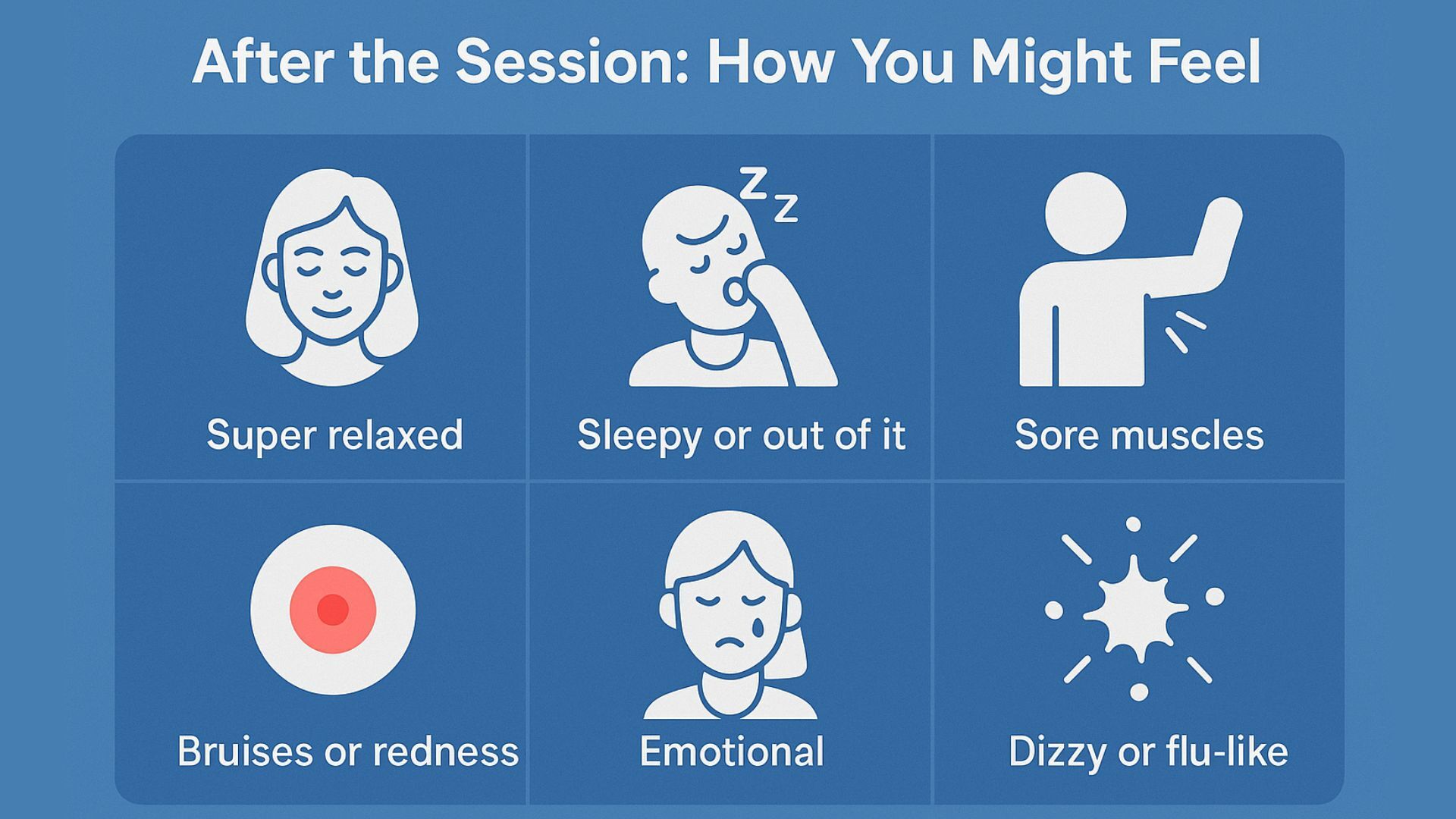How Electroacupuncture Works?
Jun 1st 2025

Electroacupuncture is a modern version of traditional acupuncture. It uses small electric pulses to make the treatment stronger. Instead of just moving the needles by hand, a small machine sends gentle electrical signals through the needles placed in your skin. This helps to wake up your nerves, improve blood flow, and ease pain.
Even though it may sound high-tech, most people find it relaxing. You might feel a soft tapping or buzzing feeling, but it usually doesn’t hurt. A session can last between 25 to 45 minutes. The practitioner can change how strong or fast the current is, depending on what your body needs. This makes the treatment very flexible and useful for many problems like long-term pain, stiff muscles, nerve issues, and even stomach or reproductive problems.
What makes electroacupuncture special is how it affects your body. It works in several ways. Near the needles, it helps blood flow better. In your spine, it can block pain messages. In your brain, it can calm down areas that deal with pain or stress. Some studies even show it might help your body heal by moving stem cells into your blood or by helping your brain make new connections.
This method still follows the ideas from Traditional Chinese Medicine (TCM), which talks about the flow of “qi” (energy) through lines in your body called meridians. Electroacupuncture just uses electric current to give a stronger push along these energy paths. It’s like combining old knowledge with new science.
But like any treatment, electroacupuncture isn’t for everyone. If you have a pacemaker, certain health problems, or seizures, it may not be safe. Most people only get mild side effects like a small bruise or some tingling. That’s why it’s important to see someone trained and licensed who can check if this therapy is right for you.
Overall, electroacupuncture is a helpful tool that mixes old and new ways of healing. It can support your body when you're dealing with pain, injury, or stress. And when done by a skilled professional, it might be just what your body needs to feel better.
What Happens During Electroacupuncture?

If you've never had electroacupuncture before, it might sound a little strange. But don’t worry, it’s a simple and safe process. You can also follow our beginner’s guide on Electroacupuncture. Here's an easy way to understand what happens during a session, step by step.
Step 1: Getting to Know You Before anything starts, the practitioner talks with you about your health, symptoms, and what you're hoping to feel better about. They might also check your pulse or look at your tongue, following traditional Chinese medicine ideas, to understand how your body is working.
Step 2: Getting Set Up Clean tools and a clean space are very important. The practitioner makes sure everything is safe and ready. You’ll lie down or sit comfortably while they get things ready, including special needles and a small machine.
Step 3: Putting In the Needles Thin, tiny needles are gently placed into your skin at specific points on your body. These spots are picked because they can help with pain, stress, or other problems. You might feel a quick pinch, but it usually doesn’t last long.
Step 4: Adding the Wires Little clips are attached to some of the needles. These clips connect to the machine, which sends a small electric current through the needles. This is what makes it electroacupuncture instead of regular acupuncture.
Step 5: Turning on the Machine The machine starts off very low. The practitioner slowly turns it up until you feel a light buzz or tingle. It should never hurt. The machine can be set to different speeds and strengths depending on what your body needs. Low settings help with long-term pain, while higher ones might help muscles relax.
Step 6: Letting It Work You rest while the machine gently sends pulses between the needles. This usually lasts 20 to 30 minutes. During this time, your body starts to relax, and many people say they feel calm or even sleepy.
Step 7: Checking In The practitioner checks on you during the session to make sure you’re comfortable. If the sensation changes or fades, they can adjust the settings a bit to keep it working well.
Step 8: Wrapping Up When the session is done, the current is turned off slowly. Then the clips and needles are taken out gently. You’ll be told to drink some water, rest, and take it easy for the rest of the day.
What You Might Feel During and After?
- A buzzing or tingling feeling
- Small muscle twitches
- A little redness or soreness where the needles were
- Feeling super relaxed or a bit tired
- Sometimes, your symptoms might feel worse before they get better
A Mix of Old and New Electroacupuncture is a mix of ancient Chinese medicine and modern technology. It's not the same for everyone, and that’s what makes it special. The treatment is adjusted to fit your needs and how your body reacts.
It's not just about the needles or the machine, it’s about helping your body heal in a natural, gentle way. Whether it’s your first time or you’ve done it before, the goal is always to help you feel better.
What Happens Inside the Body During Electroacupuncture?
Electroacupuncture might sound complicated, but what it does inside your body is actually pretty cool. When a tiny electric current flows through acupuncture needles, it sends helpful signals to different systems in your body, like your nerves, brain, muscles, and even your immune system.
Let’s break it down in a way that’s simple and easy to understand.
- It Wakes Up Your Nerves The electricity from electroacupuncture wakes up your nerves. These signals travel to your spine and brain, telling your body to release natural chemicals that help with pain.
The type of current matters:
- Low settings (2-10 Hz) make your body release endorphins, the stuff that makes you feel better naturally.
- Higher settings (50-100 Hz) help release other brain chemicals like serotonin and norepinephrine, which reduce pain and help you feel calm and balanced.
That’s why electroacupuncture can be extra helpful for people with strong or long-lasting pain as seen in a 2021 clinical trial on JAMA Oncology.
- It Calms Inflammation Inflammation causes swelling and pain. Electroacupuncture helps lower the bad chemicals in your body that cause inflammation, like IL-1, IL-6, and TNF-alpha as noted in the PMC Study.
It also boosts blood flow, bringing oxygen and nutrients to places that need to heal. This helps you feel better and recover faster.
- It Helps Your Muscles Work Better If your muscles are sore, tight, or hurt from an injury, electroacupuncture can help. The light pulses help your muscles relax, reduce spasms, and move more easily.
This is great for athletes or anyone who’s trying to heal from a strain or injury.
- It Supports Your Mood and Mind Pain doesn’t just hurt your body, it can make you feel stressed or down. Electroacupuncture helps with that too. It boosts brain chemicals like serotonin, which can lift your mood and lower anxiety.
Some people say they feel super calm or even happy after a session. It’s like your nervous system gets a little reset.
- It Might Help Your Body Heal from the Inside A 2017 VA research article says electroacupuncture might help your body release special cells (called stem cells) that repair damage. It may also affect how some genes in your body turn on and off, kind of like flipping switches that help healing.
This part still needs more research, but it’s exciting!
- It Works Across the Whole Body Electroacupuncture isn’t just for one system, it works across many:
- Nerves to stop pain
- Immune system to fight inflammation
- Blood flow system to send oxygen where it’s needed
- Hormones to keep your body balanced
- Muscles to help with movement and stiffness
Because of this, people use it for all sorts of issues, from arthritis and back pain to stress, sleep trouble, and more.
So, Does It Really Work? A lot of research says yes, especially for pain and inflammation. But it’s not a miracle cure, and it doesn’t always work the same for everyone. Some things, like treating nausea or other conditions, still need more studies.
Still, many people say they feel real relief. It’s a mix of science and traditional healing, helping your body feel better in more ways than one.
Whether you believe in energy flow or just want real results, electroacupuncture offers a gentle and natural way to support healing.
What Does Electroacupuncture Feel Like?
Electroacupuncture might sound a bit scary because it uses electricity, but it’s actually pretty gentle. Most people are surprised at how relaxing it feels.
Let’s explain what it’s really like, in simple and honest words.
Before the Electricity: What the Needles Feel Like
Just like regular acupuncture, electroacupuncture begins with very thin, clean needles. These needles go into certain spots on your body. You might feel a tiny pinch, sting, or even nothing at all when they go in.
Some places, like your hands or feet, might be more sensitive. You could feel a bit of heaviness or a little muscle jump. But don’t worry, that’s normal and it goes away quickly.
When the Electricity Starts: What It Feels Like?

Once the needles are in, the acupuncturist connects a small machine like 12c. Pro Advanced, Electrostimulator 8c.Pro This machine sends gentle electric pulses between a few of the needles.
Here’s what people usually feel:
- A soft buzzing or tingling
- A light pulsing that comes and goes
- Gentle muscle twitches
- A heavy or full feeling in one spot
- A little warmth or a humming feeling
It’s not painful, just different. The strength of the feeling can be turned up or down, depending on what feels okay to you. If anything feels too strong, the acupuncturist will adjust it right away with our best electro acupuncture stimulators.
Fun fact: Some people feel a strange sensation in a totally different spot, like a buzz in the foot even if the needle is in the back. That’s because nerves are connected in cool ways.
During the Session: What Happens?
A session usually lasts 15 to 40 minutes. The electric pulses stay steady during that time. Some people stop noticing the pulses after a while, and that’s normal. The acupuncturist might slowly turn it up again, but only if you’re okay with it.
You’ll lie still, maybe with music or soft lights. Lots of people feel calm or sleepy.
After the Session: How You Might Feel?

When the treatment ends and the needles come out, you might notice:
- Feeling super relaxed
- Feeling a little sleepy or out of it
- Sore muscles, like after a workout
- Tiny bruises or redness where the needles were
- Feeling emotional, like laughing or even crying
Some people feel more energetic. Others want a nap. Some might feel a bit dizzy or have flu-like feelings for a short time, but those usually go away quickly.
What to Know? Everyone Feels It Differently
Not everyone feels the same things. One person might feel light buzzing, another might feel muscle twitches. Both are okay.
Your acupuncturist is there to make sure you’re safe and comfortable. In some places, they even give you a button to press if you want help during the session. You’re always in control.
And if you’re nervous before your first visit, that’s completely normal.
- When needles go in: A tiny pinch or pressure
- During: Buzzing, tingling, pulsing, not painful
- After: Calm, maybe tired or full of energy
Most people say, “That felt way better than I expected.”
When done by someone who’s trained, electroacupuncture mixes old healing methods with a bit of modern tech. The result? A treatment that can help you feel better, and maybe even enjoy the process.
And if you're still wondering if it’s right for you, just remember: You’re in control the whole time, and your body will let you know what feels right.
When Is Electroacupuncture Most Helpful?
Electroacupuncture is a special kind of acupuncture that uses a tiny bit of electricity. It might sound a little high-tech, but it’s actually used for many everyday health problems, especially when someone needs stronger or deeper results than regular acupuncture can give.
Let’s look at the most common reasons people try electroacupuncture, explained in a simple way.
- Pain Relief, For Long-Lasting or Sudden Pain
Most people try electroacupuncture to deal with pain. It can help with all sorts:
- Chronic pain: If you’ve had back pain, arthritis, or stiff joints for a long time, this treatment might ease pain by helping your body release natural painkillers and improve blood flow.
- Sudden (acute) pain: After surgery or an injury, it can help lower the need for strong pain medicine.
- Muscle and joint pain: Things like sore shoulders, tight necks, or aching knees can feel better with this treatment.
- Nerve pain: Pain from sciatica or numbness from nerve damage may improve because this treatment helps the nerves work better.
- Helping Nerves and the Brain Heal
Electroacupuncture also supports the brain and nervous system. Here’s how:
- Stroke recovery: It might help people regain movement after a stroke when used with physical therapy.
- Bell’s palsy: This condition causes sudden facial muscle weakness, and electroacupuncture can help muscles work better this was noted in ScienceDirect Overview.
- Weak or tired muscles: It can wake up muscles that haven’t been used for a while.
- Parkinson’s: Some early research shows it might help with tremors and stiffness, but more study is needed.
- For Mental Health and Sleep
This treatment doesn’t just work on the body, it can help the mind too.
- Depression and anxiety: Systematic studies on PubMed show it works as well as mild antidepressants by helping your brain produce calming chemicals.
- Stress: It can help your nervous system relax, especially during tough times.
- Sleep problems: If you can’t sleep well, this treatment might help your brain calm down at night.
- Supporting Cancer Treatment and Chronic Illness
Electroacupuncture can also support people going through cancer treatment or long-term illness:
- Nausea from chemo: It can help with queasy feelings, especially when medicine doesn’t work.
- Fatigue: It may boost energy and help the immune system.
- Nerve pain after chemo: It can protect nerves or help them heal.
- Women’s Health
Electroacupuncture may also help with hormone problems or women’s health concerns:
- Polycystic Ovary Syndrome (PCOS): It may balance hormones, help with regular periods, and boost fertility.
- IVF and fertility treatments: It’s sometimes used to make egg retrieval easier and less painful.
- Bladder leaks and pelvic pain: Some women feel relief when this treatment is added to physical therapy.
- Other Helpful Uses
- Addiction support: Some rehab centers use it to help people quit smoking or manage cravings.
- Digestion: It can calm the gut and help with constipation.
- Inflammation and arthritis: It may help reduce swelling and joint pain.
- Sports recovery: Athletes use it to relax muscles and speed up healing.
- Healing and circulation: It may help bring more blood and nutrients to injured parts of the body.
Electroacupuncture can be a helpful tool when you’re dealing with tough or ongoing health problems, especially pain, nerve issues, hormone imbalances, or chronic illness. But it’s not a magic fix, and it’s not for everyone.
If you’re curious about trying it, talk to someone trained and experienced. They can adjust the settings and placement just for you. And remember, this treatment usually works best when it’s part of a bigger plan to help you feel better.
